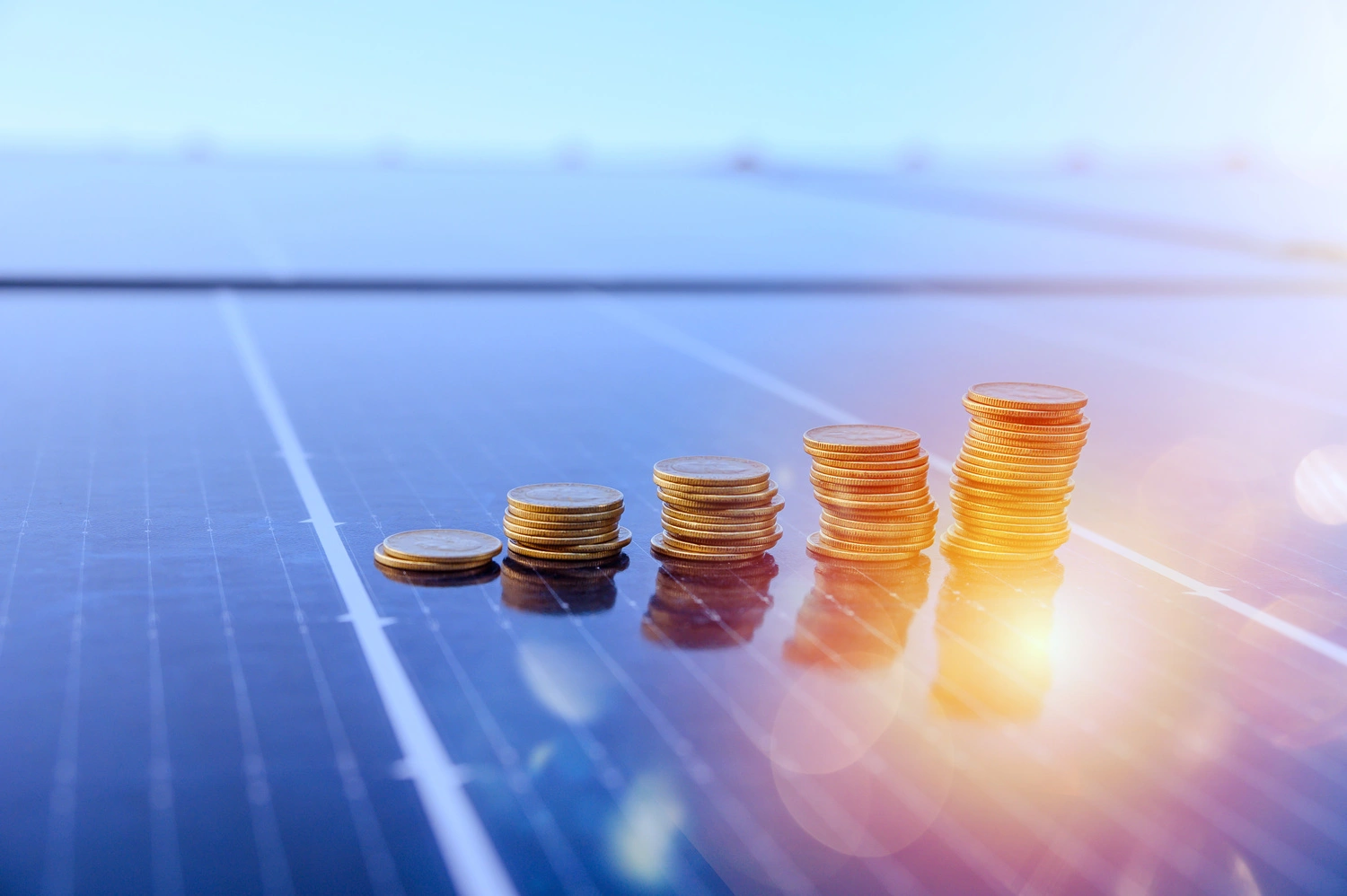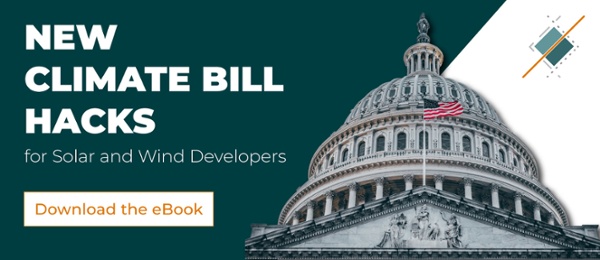6 min read
How Our Current Economy Will Impact Renewable Energy Development
![]() Transect Team
:
Mar 30, 2023
Transect Team
:
Mar 30, 2023

Listen to the audio version
Keeping on trend with the back-to-back/simultaneous crises of the pandemic and lockdowns, diplomatic instability, and inflation, experts are warning of some spicy economic times ahead.
-
The clean energy space is projected to grow, despite current economic trends
-
Automation will play a role in cutting down development timelines and completing more project developments faster
-
The Inflation Reduction Act (IRA) is set to play a significant role in financially supporting the growth of the renewable market and land developers’ upcoming clean energy projects
The current widespread price inflation resulted from a combination of factors, including supply chain disruptions and the rapid resurgence of consumer demand following the sudden decrease in demand during the initial period of the pandemic. To combat the current high inflation rate, the United States Federal Reserve, the Fed, has repeatedly raised interest rates, making it more expensive to borrow money and ultimately “cooling off” the market by discouraging spending and reducing demand. In early February 2023, the Fed held its eighth consecutive meeting resulting in a decision to raise interest rates. If you need to borrow money, most people would say that now is not really the best time…
Listen, we aren’t panicking and telling you to hit the “global economy financial crisis” alarm just yet. We are just saying that land developers may want to take a second to plan their clean energy investments and know that some industries maaayyy not experience massive economic growth at this point in time. In the case of renewables developers, breaking ground on that new wind or solar project just got a whole lot more expensive.
But wait! There is hope for friends developing solar fields, wind farms and battery storage project alike!
Let’s get to the good news for clean energy developers. Historically, recessions have seen greater growth of the renewable energy market than fossil fuels, high interest rates mean that for capital-intensive projects such as emerging renewable energy producers. What does this mean? Well it just means that with the proper tools in your metaphorical toolbox, the current economy will not stall your clean energy development goals.
Ah good old’ (but not that old) renewable energy development. The yin to the yang of well…..everything else happening economically right now.
How Much Did that Pocketful of Sunshine Really Cost?
Let’s talk sun costs.
While the sun transmits light and those pesky harmful UV rays to us directly, getting the sun’s energy into your electric toothbrush takes quite some time. From electric cars to solar-powered communities, wind, and solar energy are becoming hot ticket items these days. Therefore, the time it takes for those sweet, sweet rays of sunshine to make it down to our products and the manufacturing time required to create all the parts needed for a wind or solar farm is incredibly important.
Keeping this in mind, we know time = money now more than ever for renewables developers. Finding any way to shave down processes for land developers is crucial to ensuring the growth of the renewable market. From manufacturing materials to project siting, cutting down project timelines is key to more renewables in the field and money back in the land developer’s pockets.
Saving a Dollar Will Make You Holler
Renewable energy projects can be limited by the closer scrutiny of the public and have received some pushback due to negative impacts on birds and bats. This public pushback is likely to delay projects more frequently as sustainability becomes a more common theme to the public. To avoid this, we recommend land developers practice early environmental due diligence to find the perfect site for their project, mitigate risk early on, and avoid excessive slowdowns.
Early-stage siting and environmental due diligence will help keep a lid on development costs. You're already well on your way by saving thousands on the initial report. But the real money saver is the avoided risk — you didn't buy a site with many issues that will delay project completion and your ability to deliver energy to your customers. You didn't spend weeks waiting on the report to come back to square one, mitigating the environmental effects on your site. Don't even get us started on the millions you could spend on mitigation costs for a site…
By knowing what permits you need for your site and what risks are present early on in development, you can mitigate your risks before they appear — fewer delays = fewer days between starting your project and generating energy to see your ROI.
Using automation to shave down land development processes such as siting and environmental permitting allows for projects heading out the door faster and going on a piece of land that suits their land use needs and not on a piece of land riddled with environmental red flags that will ultimately stall their project. These tools can save land developers time and money (a.k.a money x2) and lead to significant renewables growth, even in our current economy.
The IRS is Your New BFF
Now I’m sure you’re thinking, is there a light at the end of the economic tunnel? Is there an extreme couponers for renewables development? The answer is, sort of?
Tax incentives provided within the Inflation Reduction Act help alleviate some of the financial and timeline burdens for manufacturers and land developers alike. The IRA provided financial incentives for domestic manufacturing and solar developments! With increased sustainability and clean energy demand, domestic manufacturing will help keep jobs on the way and serve as an incentive to create more solar power projects rapidly. The short-term increase in the cost of the products due to different working conditions standards (and, you know, basic business operations…) will seem daunting.
The act also describes energy communities. What are those? Great question. These are areas that when developing within them, you receive extra financial benefits that are laid out within the act. Unsure if you live in an energy community? Use online tools and software such as Transect that allow you to see if your next solar project lies within the boundaries of an energy community.
An honorable mention: The ever-famous Solar ITC was also extended by the IRA, allowing for more help for solar developers! This specific tax credit allows for additional aid for those developing solar farms or communities.
We can avoid complications outside of our control by utilizing our tax incentives while they are fresh off the press and taking over much of the manufacturing and development processes. Manufacturing, assembling, and operating all components of renewable energy production without crossing borders advances US energy security, an overarching theme of the Inflation Reduction Act.
Sun, Wind, and Batteries
Money Talk 101: The actions happening across the world impact our economy. This will happen with solar panels too! But wait! We have an act for that *cough cough* the Inflation Reduction Act that is…
US solar, wind and other energy technologies can expect to benefit from the Inflation Reduction Act’s provisions, which include $60 billion for investment in manufacturing capabilities. The Act also includes $30 billion in tax credits for green energy producers and a $10 billion investment tax credit to incentivize the construction of manufacturing facilities that produce renewable energy components such as PV cell components and wind turbines. The idea is to get money behind the technological advances in renewable energy that will make it cheaper and more efficient and an obvious choice over so-last-century fossil fuels.
Batteries Are Underrated
When it comes to both solar and wind, energy production is only part of the picture. Unlike fossil fuels, which can be stored in liquid form in any water-tight container, you can’t keep a gallon of wind energy in the back for emergencies. That’s where battery technology comes in. Japan and Korea are recognized leaders in global battery technology, and the National Renewable Energy Laboratory says they believe there’s potential for renewable energy to become 3,000% more efficient by 2050. Key innovations include reducing or eliminating the use of raw materials such as cobalt, which is limited to where it’s naturally deposited. Cobalt mining in the Democratic Republic of Congo (DRC), which supplies 70% of global cobalt, has been linked to human rights abuses. Beyond the moral imperative, reducing dependence on cobalt from the DRC protects battery production from the volatility of dependence on one state for trade.
To advance renewable energy, the Inflation Reduction Act also includes incentives to encourage sales of electric vehicles (EVs) and EV manufacturing in the US. This includes a tax credit of up to $7,500 per EV and will be in place through 2032. The act also includes tax credits for purchasing a used EV for the first time ever. Used EV tax credits are $4,000 or 30% of the sale price, whichever is lower. Sweet ride, indeed.
This information circles back to our common theme that everything everywhere, all at once, impacts our energy system. The push for domestic development of energy technologies combined with our fluctuating interest rates is an attempt to allow our energy market to survive both our economic highs and lows and avoid potential manufacturing and energy policies set by other nations.
Let’s Talk Oil Money…Oil prices, that Is…
Russia’s ended its supply of natural gas supplies to the European Union in 2022, causing an energy crisis as Europe scrambled to meet energy supply needs, particularly in Germany. While Germany was reticent to bring coal plants slated to be phased out back online, few other options wouldn’t give Russia an upper hand at the negotiating table. Unfortunately, this cold turkey cutoff, which came in retaliation for Western sanctions, unfortunately made natural gas more scarce and expensive and even forced a return to coal in some parts of Europe to ensure energy needs are met. This instability has caused a rise in global fuel prices, which drives (literally) a rise in the cost of living as transportation and construction costs increase. No worries, Germany, you’re doing great — Australia still uses 70% fossil fuels for its energy.
As we were saying, not every market thrives in economic and political hardship, right? This is a prime example of how the clean energy sector has a bright future ahead, despite current conditions. See what we did there?
These impacts on the fossil fuel industry make diversifying our energy sources a necessity now more than ever.
Even in our current economy, reaching our climate change goals is a priority. Providing stable, affordable clean energy can manage energy prices for the consumer while the growing market will help create jobs nationally. Controlling our development processes from beginning to end and utilizing automation are key to not just surviving but thriving right now.
Our innovation and willingness to change our process will determine how our industry and individual companies will emerge at the end of these economic challenges.
Utilizing the tax credits and automation at our disposal will ultimately lead us to our clean energy goals. From using Transect to find energy communities or using it to identify environmental red flags early on, changing current processes means changing the entire energy industry.
Learn how to speed up your development process while saving money and avoiding expensive delays by scheduling a demo today!



